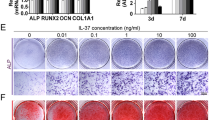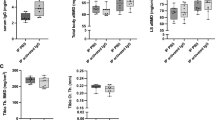Abstract
Three human cell lines derived from oro-pharyngeal squamous cell carcinomas of the head were investigated for bone-resorbing activity in vitro. Culture media from all three spontaneously produced a non-dialysable osteolytic factor with activity in three in vitro assays for interleukin 1 (IL1), viz. the lymphocyte activating factor (LAF) assay, stimulation of collagenase synthesis by articular chondrocytes, and stimulation of prostaglandin E2 synthesis by fibroblasts. Addition of anti-human IL1 antibody to the culture media abolished all the bone-resorbing activity. Fractionation of the cell culture media by high performance liquid chromatography (HPLC) showed a single peak of activity in the chondrocyte assay with an apparent mol.wt of 15-17,000. This co-eluted with activity in a preparation of IL1 from rat peritoneal macrophage cultures. These results indicate that IL1 is responsible for the prostaglandin-independent bone resorbing activity synthesised by these cells in vitro, and may contribute to the bone destruction associated with the tumour.
This is a preview of subscription content, access via your institution
Access options
Subscribe to this journal
Receive 24 print issues and online access
$259.00 per year
only $10.79 per issue
Buy this article
- Purchase on Springer Link
- Instant access to full article PDF
Prices may be subject to local taxes which are calculated during checkout
Similar content being viewed by others
Author information
Authors and Affiliations
Rights and permissions
About this article
Cite this article
Meghji, S., Sandy, J., Scutt, A. et al. Macromolecular osteolytic factor synthesised by squamous carcinoma cell lines from the head and neck in vitro is interleukin 1. Br J Cancer 58, 17–21 (1988). https://doi.org/10.1038/bjc.1988.153
Issue Date:
DOI: https://doi.org/10.1038/bjc.1988.153
This article is cited by
-
Cell, tissue and organ culture as in vitro models to study the biology of squamous cell carcinomas of the head and neck
Cancer and Metastasis Review (1996)



